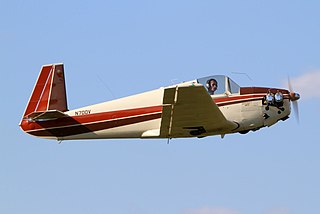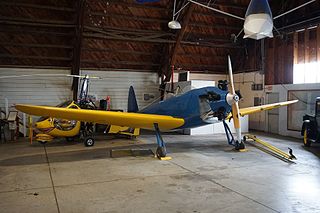
The Mooney M-18 "Mite" is a low-wing, single-seat monoplane with retractable, tricycle landing gear.

The Aeronca L is a 1930s American cabin monoplane designed and built, in small numbers, by Aeronca Aircraft. It differed significantly from other Aeronca planes by the use of radial engines, streamlining, and a cantilever low wing.

The Auster J/4 was a 1940s British single-engined two-seat high-wing touring monoplane built by Auster Aircraft Limited at Rearsby, Leicestershire.

The Culver Dart was a 1930s American two-seat light monoplane aircraft produced by the Dart Aircraft Company.

The Cessna Model A is a 1920s American high-wing four-seat tourer built by the Cessna Aircraft Company, the first in a long line of high-wing single-engined monoplanes.
The Kinner Sportster was a 1930s American light monoplane built by Kinner Airplane & Motor Corporation.

The Kinner Sportwing was a 1930s American light monoplane built by Kinner Airplane & Motor Corporation.

The Kinner R Playboy was a 1930s American two-seat sporting monoplane built by Kinner Airplane & Motor Corporation.

The Goodyear GA-2 Duck is a 1940s American three-seat light amphibious aircraft built by the Goodyear Aircraft Corporation. The design team included David Thurston, who later developed several other light seaplanes including the Colonial Skimmer, Lake Buccaneer, Thurston Teal and Seafire. Only 19 aircraft were built, and these were used only for testing and as demonstrators.

The Harlow PC-5 was a 1930s American military trainer version of the PJC-2, and was designed and built by the Harlow Aircraft Company and license-produced by the Hindustan Aeronautics Limited in India.

The Fairchild 22 Model C7 was an American two-seat touring or training monoplane designed and built by the Kreider-Reisner division of the Fairchild Aircraft Corporation at Hagerstown, Maryland. The aircraft has a parasol wing configuration and was used with a variety of engines; 127 were produced from 1931 to 1935.

The PZL-102 Kos (blackbird) is a Polish two-seat touring and training monoplane designed and built by PZL.
The Partenavia P.59 Jolly was an Italian two-seat training monoplane designed by Partenavia to meet a requirement for the Aero Club d'Italia. First fight was in 1960.

The Ryan S-C (Sports-Coupe) was an American three-seat cabin monoplane designed and built by the Ryan Aeronautical Company. At least one was impressed into service with the United States Army Air Forces as the L-10.

The Luscombe Phantom was a 1930s American two-seat cabin monoplane and the first product of the Luscombe Aircraft Engineering Company.

The Mohawk M1C was a 1920s American two or three-seat low-wing monoplane designed and built by Mohawk Aero Corporation of Minneapolis, Minnesota. One M1C was evaluated by the United States Army Air Corps in 1930 as the YPT-7 Pinto for use as a primary trainer.

The Pasped W-1 Skylark is a 1930s American two-seat single-engined cabin monoplane designed and built by the Pasped Aircraft Company of Glendale, California.

The Howard DGA-18 was an American two-seat basic training aircraft designed and built by the Howard Aircraft Corporation for the United States Civil Pilot Training Program.
The St. Louis C2 Cardinal family are a series of light sport monoplanes built by the St. Louis Aircraft Corporation during the peak of the Lindbergh Boom after the Spirit of St. Louis flight of 1927.

The Elias EC-1 Aircoupe was an American two-seat parasol wing monoplane designed and built by Elias of Buffalo, New York.


















